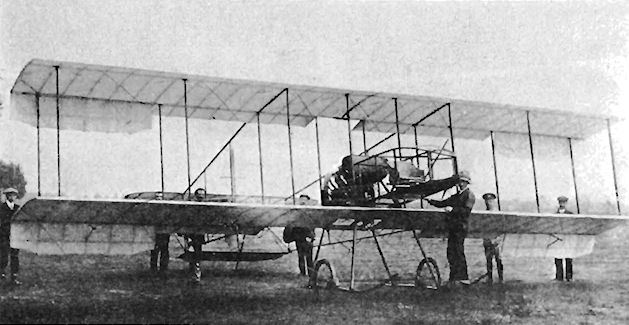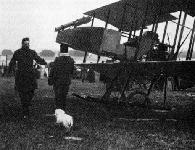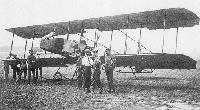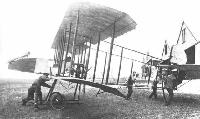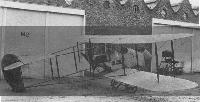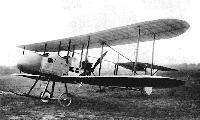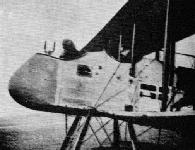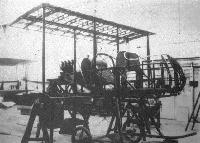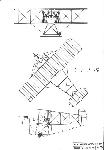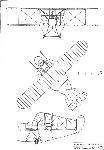A.Jackson De Havilland Aircraft since 1909 (Putnam)
Royal Aircraft Factory F.E.2
This was an improved aeroplane powered by a 50 h.p. Gnome, similar to the F.E. 1 in its final form, but fitted with a sesquiplane tail unit and a wood and canvas nacelle with two seats. On its first outing at Farnborough on August 16, 1911 it taxied only 50 yards before a piston broke up and the pieces were ejected through an exhaust port but, at 6.30 a.m. on August 18, Geoffrey de Havilland successfully flew it the short distance to Laffan's Plain and made four landings. Tail heaviness made gliding difficult but with more than 50 lb. of lead in the nose it flew well although this was later reduced when a monoplane tail unit was fitted.
On December 6, 1911 de Havilland flew the F.E.2 to Shrewton, near Larkhill, and after lunch returned to Farnborough having covered 100 miles in 2 3/4 hours flying time and, following a 'height test' to 1,900 ft. before the official observer, Capt. Burke, on December 23, qualified for the Royal Aero Club's Special Aviator's Certificate.
The aircraft was persistently right wing low but, after repeated rigging adjustments, was taken over to Fleet Pond where the wheels were removed, the skids were bolted to a single, shallow-draught float, and tail and wing tip floats fitted. First flights from the water, totalling 3/4 hr., were made by de Havilland on April 12,1912 but, with the drag of the float, 50 h.p. was not enough and the F.E.2 went back to Farnborough where the original engine was replaced by a 70 h.p. Gnome. It first flew with this engine on April 26 and was flown to the Pond next day for the float to be refitted. With extra power, water take-offs with pilot and passenger were quite good and the aircraft then went on to enjoy a comparatively long career on both wheel and float undercarriages.
It was employed later in 1912 for trials with a Maxim machine gun mounted in the nose and in 1913 was extensively reworked with 70 h.p. Renault Vee 8 engine, streamlined nacelle, new outer wing panels which increased the span to 42 ft., tailplane raised to the top longerons, and a smaller rudder. In this form it resembled the larger and later F.E. types which were built in quantity.
During a trip to the South Coast piloted by Royal Aircraft Factory test pilot Ronald Kemp on February 23,1914, it spiralled into the ground from 500 ft. at West Wittering, seven miles from Chichester, Sussex, due it was said, to the absence of fixed fin area to offset the increased keel surface of the new nacelle. Passenger E. T. Haynes, a civilian scientist at the Factory, was killed and the aircraft destroyed.
SPECIFICATION AND DATA
Construction: By the Royal Aircraft Factory, Farnborough, Hants.
Power Plants:
One 50 h.p. Gnome
One 70 h.p. Gnome
One 70 h.p. Renault
Dimensions:
Span 33 ft. 0 in. (increased to 42 ft. 0 in. in 1913)
Length 28 ft. 0 in. Wing area 340 sq. ft.
Weights: All-up weight 1,200 lb.
Performance: Maximum speed 47.5 m.p.h.
P.Hare Royal Aircraft Factory (Putnam)
F.E.2
Two broadly similar but entirely separate aeroplanes each received the designation F.E.2 (without a suffix), although it is believed that the second machine was, officially at least, a rebuild of the first. In the same way it was, and occasionally still is, alleged that the first of the F.E.2s was a reconstruction of its predecessor, the de Havilland-built F.E.1. However, at the time of the F.E.1's last recorded flight, which was made on 15 August 1911 and ended in a crash, the F.E.2 was already complete and ready for flight, awaiting Geoffrey de Havilland's return from his holidays.
The wings, tail and undercarriage of the F.E.2 closely resembled those of the earlier machine, but there were numerous detail changes. These included a reduced cut-out in the upper wing centre-section, ailerons of increased span on upper and lower wings, and a simple nacelle to afford the crew some protection from the elements. Power was provided by a 50hp Gnome rotary which unfortunately proved to be a constant source of irritation. The first take-off, on 16 August, had to be aborted after a run of only fifty yards when a piston broke. This was replaced, and another attempt was made two days later when, despite constant misfiring, four circuits of Laffan's Plain were made. De Havilland, who was responsible for the machine's testing as well as for its design, reported that its lateral control was good but that it was tail heavy, and that, as a consequence, gliding was particularly difficult. Two further circuits were made on the evening of the same day with fifty pounds of lead in the nose, but the centre of gravity was still too far back. This problem was resolved by the end of the month, most probably by re-rigging, and de Havilland reported that the machine was 'flying well' and was very stable, although he felt that more rudder movement was required.
A test flight on 1 September, after the rudders had been modified, was cut short when an inlet valve broke, and the next flight, a few days later, was similarly abbreviated, the problem on this occasion being with the petrol feed. Engine troubles plagued almost every flight until 22 September, when de Havilland records that the engine was running better because the valves had been cleaned. On the same date the lower part of the machine's biplane tail was removed, and subsequently the wings were treated with the new dope Emaillite and a new propeller was fitted.
Finally the F.E.2 appears to have been satisfactory, and it made many flights, frequently carrying a passenger, throughout the remainder of 1911. In November it was fitted with dual controls, initially to the elevator and rudder only, but these were later provided for the ailerons as well.
On 6 December de Havilland flew the F.E.2 to Larkhill on Salisbury Plain, and then on to Shrewton, before returning to Farnborough, covering 100 miles in a flight time of 2 3/4 hrs, this flight being one of the tests for his Superior Aviator's Certificate. A climb to 1,900ft on 23 December appears to have been a further part of the qualifying tests.
Some time in the new year (1912) a set of floats was designed to enable the F.E.2 to operate from water, and on 3 April the machine was flown to Fleet Pond, its wheels removed, and the floats fitted in their place. Problems were experienced in launching owing to the low level of the water, but once afloat the 'Hydro-Aeroplane' F.E.2 was found to ride well. The engine was started in the usual way, a mechanic wading into the shallow water to provide the necessary muscle power to swing the propeller. Steering was found to be as easy as on land, and then, after a run of about 100 yards, the machine took off, piloted by Mr Perry, and landed successfully after a short flight. Six flights were made in all, each of about a quarter of a mile and at a height of about twenty feet.
Later that month the troublesome engine was replaced by a new one, this time of 70hp, and on the 27th it was again flown to Fleet Pond, this time by de Havilland, for the floats to be fitted. Two days later it made a number of flights from the pond, again piloted by de Havilland, its increased power enabling a passenger to be carried. Curiously the experiment seems to have stopped at this point, and the results of the trials were reported to the War Office. It is possible that the floats were transferred to the B.E.2 for similar trials.
Following its success as a seaplane, the F.E.2 was again modified, the intention on this occasion being to enable it to carry a machine gun. The undercarriage was strengthened and the tailplane re-set to balance the additional weight, and a belt-fed Maxim gun was fitted to the nose, where it could be aimed and operated by the passenger. Tests revealed that a gunner in such a machine was blessed with a wide arc of fire, but could only take advantage of much of the potential range of elevation by kneeling or standing up as appropriate. It was concluded that a special mounting giving a variable-height pivot point would be required to enable such a gun to be used effectively.
The second and separate F.E.2 was built during 1913, possibly using components from the earlier machine. It had a capacious but well streamlined nacelle, a 70hp Renault V-8 engine, and outer wing panels copied from those of the B.E.2. The monoplane tailplane was mounted on to the upper tailbooms and braced by struts to the lower booms. The rudder was fairly large and had no balance area. There was no fin, an omission which very probably brought about its end, for on 23 February 1914, after a period of satisfactory testing, it spun to the ground from a height of 500ft and was wrecked. The pilot, Ronald Kemp, who had by that time replaced Geoffrey de Havilland as the Factory's chief test pilot, suffered a broken leg, and his passenger, Mr E T Haynes, was killed.
1911 version
Powerplant: 50hp Gnome rotary
Dimensions:
span 33ft 0in
wing area 340 sq ft;
length 28ft 0in;
Weight: 1,200lb (loaded).
Performance:
max speed 48mph at sea level;
initial climb 140ft/min (with passenger).
1913 version
Powerplant: 70hp Renault V-8
Dimensions:
span 42ft 0in
wing area 425 sq ft;
length 30ft 0in;
Weight: 1,865lb (loaded).
Performance:
max speed 67mph at sea level;
initial climb 330ft/min;
ceiling 5,500ft.
H.King Armament of British Aircraft (Putnam)
F.E.2. The genesis of the F.E.2 is of exceptional interest, especially in respect of armament. It first appeared, with 50-hp Gnome engine, in September 1911, having been rebuilt from the crashed F.E.1, which was Geoffrey de Havilland's second aeroplane (Farman Experimental No.1). By the time of the British Military trials, on Salisbury Plain in August 1912, this aircraft had been fitted with a Maxim machine-gun, as a photograph shows. The gun, which appears to have been of 0.303-in calibre, was mounted on trunnions in a fork-shaped member some distance aft from the nose of the nacelle, allowing the muzzle end of the barrel casing to rest on the tip of the nacelle. The gun was lashed in this position by two lengths of rope. As rebuilt early in 1913 with a 70-hp Renault engine the F.E.2 had a nacelle of revised form, associated with a very large gun-carrying member as seen in another photograph. That in this form the aircraft was intended to carry a heavy gun is suggested by a statement by F. W. Lanchester that the F.E.2 was designed to carry a 'gun weight' of 300 lb. This figure probably included mounting and ammunition, and the weapon concerned may well have been the Coventry Ordnance Works 1-pounder as tested in the F.E.3 during 1913.
M.Goodall, A.Tagg British Aircraft before the Great War (Schiffer)
Deleted by request of (c)Schiffer Publishing
FE.2 1911 and 1913 versions
Two distinct versions of this aircraft were built, the first of which made its first attempt at flight on 16 August 1911, which was aborted due to engine failure.
1911 version. This machine was a typical pusher biplane with a nacelle for the crew with single acting ailerons on all four wings, which consisted of two bays outboard of the tail boom struts.
The tailbooms comprised three bays and originally carried a biplane tail with single rudder between; the lower tailplane was soon removed and the rudder area increased by making it taller. The two wheel and twin skid undercarriage was mounted below the wings.
In April 1912 the FE.2 was tested on Fleet Pond as a seaplane, with large central float fitted under the undercarriage skids, together with a tail float and small wingtip floats. A new and more powerful engine was fitted, enabling a passenger to be carried successfully.
After reconversion to wheel undercarriage, limited tests were carried out with a Maxim gun fitted to the front cockpit.
Power: 50 and 70hp Gnome seven-cylinder air-cooled rotary with four-bladed propeller
Data
Span 33ft
Weight allup 1,2001b.
Area 340 sq. ft
Max speed 48 mph
Length 28ft
Climb with passenger 140 ft per min
1913 version. The second version of the machine was quite different from the first, although some parts of the earlier machine may have been used in its construction. It does not appear on the RAE list as a new machine in 1913.
The center section, enclosed within the tailboom struts, was broad; the outer wings, reported to be of BE.2a origin, were of single bay type with a large unsupported outer section with rounded tips and warping control. A deeper nacelle than its predecessor's, was mounted on a similar two wheel and twin skid undercarriage, but with mounting struts forward of the wings.
The tail booms tapered inwards more acutely and the top members sloped down more steeply. The tailplane, with divided elevators, was mounted on the top members and braced with struts to the lower members. A large unbalanced rudder was fitted but no fin. This FE.2 was wrecked on 2 October 1914, when being flown by R. Kemp, the passenger E.T Haynes being killed in the crash.
Power: 70hp Renault eight-cylinder air-cooled vee with four-bladed propeller
Data
Span 42ft
Area 425 sq. ft
Length 30ft
Weight allup 1,865 1b.
Max speed 67 mph
Climb 330ft per min initially
Ceiling 5,500ft
P.Lewis British Aircraft 1809-1914 (Putnam)
F.E.2 - 1911
Rebuilding of the crashed F.E.1 took place during September, 1911, and a 50 h.p. Gnome was installed in place of the original iris engine. Several other changes were made at the same time, including the discarding of the front elevator - which resulted in a reduction in overall length from 40 ft. to 28 ft. - the fitting of a revised tail unit, an alteration to the wing section and the installation of dual controls in a two-seater nacelle. All-up weight was consequently increased to 1,200 lb., and the rebuilt F.E.1 was redesignated F.E.2.
For the next year the F.E.2 was flown extensively and was used for experimental purposes on several occasions, among them the fitting of a free-firing Maxim machine-gun on a crude mounting in the nose of the nacelle. Tests were conducted also as a seaplane from Fleet Pond, the land undercarriage being replaced by a central float. Span, 33 ft. Length, 28 ft. Wing area, 340 sq. ft. Weight loaded, 1,200 lb. Maximum speed, 47-5 m.p.h.
F.E.2 - 1913
Early in 1913, the F.E.2 went into the workshops again for complete rebuilding as a two-seat gun-carrier, serving as the prototype of the F.E. (Fighting Experimental) series. New outer wings of the same planform as those of the B.E.2a were fitted, resulting in an increase of span to 42 ft. The loaded weight went up by 50%, and the new engine installed was a 70 h.p. Renault. At the same time, the gun in the nose was given an improved mounting. After a further year of life, the F.E.2 was finally written off when it crashed near Wittering on 23rd February, 1914, owing to insufficient fin area being embodied to balance the increase in side area which took place at the nose with the installation of the nacelle. The pilot at the time of the accident was Ronald Kemp, whose passenger. E. T. Haynes, was killed. Span, 42 ft. Length, 30 ft. Wing area. 425 sq. ft. Weight loaded. 1.865 lb. Maximum speed. 67 m.p.h. Climb, 330 ft./min. Ceiling, 5.500 ft.
P.Lewis The British Fighter since 1912 (Putnam)
Since the days when it had been the Balloon Factory, the Army Aircraft Factory had naturally, in its daily association with the military aspect of aeronautics at Farnborough, been conscious of some degree of war potential in the aeroplane and had experimented accordingly with wireless and photography. Eventually, it was realized that an aeroplane reconnoitring enemy positions might need to carry its own defensive armament, and to test such an installation a Maxim free-firing machine-gun was fitted on a simple mounting in the nose of the nacelle of the F.E.2 biplane during 1912. The F.E.2 was originally the F.E.1 which had been reconstructed in 1911 with modifications following its crash during the Summer of the same year while being flown by Lt. T. J. Ridge, then the Factory’s Assistant Superintendent. The Iris engine had been replaced by the popular 50 h.p. Gnome and crew comfort was improved by the addition of a two-seat covered nacelle projecting in front of the lower wings.
The way ahead to the evolution of the armed scout was clearly opening up. Successful tests throughout the year prompted yet another rebuilding of the long-suffering F.E.2, and early in 1913 the machine was completely redesigned and reconstructed as a two-seat gun-carrier of greatly refined aspect compared with its earlier appearance. The former crude, slab-sided nacelle had given way to a new structure of far cleaner and pleasanter aerodynamic form with good protection for the tandem-seated crew. Behind them was the increased power of a 70 h.p. Renault engine driving a four-blade propeller. The well-rounded plan-form of the B.E.2a was evident in the new outer wing panels and the entire tail unit had been revised, attention being paid also to cleaning up the landing gear. The gun mounting in the nose had been improved and, altogether, the new F.E.2 presented an extremely workmanlike appearance. The alterations had brought the span up to 42 ft. and increased the loaded weight by 50%. The top speed also had been improved to 67 m.p.h. The machine continued to be flown for the rest of the year but its end came abruptly on 23rd February, 1914, when it crashed near Wittering while being flown by Ronald Kemp, with fatal consequences to the other occupant, E. T. Haynes. The cause of the accident was ascertained to have been lack of fin area to balance the forward side area which had increased when the new enlarged nacelle had been fitted. Nevertheless, the F.E.2. had served the Factory well and had proved to be very good value at the £400 which the War Office had paid originally for it. In its final metamorphosis the machine played the part of the progenitor of the Fighting Experimental series of pusher biplanes the first of which, the F.E.2a, had been designed at the Factory during August, 1913, some six months before the F.E.2’s demise.

